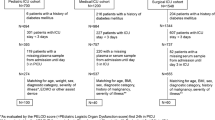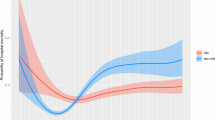Abstract
Objective
We investigated whether preventing hyperglycemia in septic patients affected the plasma concentration of asymmetric-dimethylarginine and if this was associated with clinical benefit.
Design
A prospective, multicenter, randomized, controlled, clinical study.
Setting
Intensive care units (ICU) in three university hospitals.
Patients
A total of 72 patients admitted for severe sepsis or septic shock, who stayed at least 3 days in the ICU. At admission the patients were assigned to receive either tight or conventional glycemic control.
Interventions
Determination of circulating levels of asymmetric-dimethylarginine, arginine, interleukin-6, C-reactive-protein and tumor-necrosis-factor-α.
Measurements and results
Blood was sampled at admission (no differences between groups), and on the 3rd, 6th, 9th, and 12th (T12) days. Sequential organ failure assessment was scored at each sampling time. All the data were analyzed on an intention-to-treat basis. The control and treatment groups received the same energy intake, glycemia (110.4 ± 17.3 vs. 163.0 ± 28.9 mg/dL, P < 0.001) and insulin (P = 0.02) supply differed. No differences were found in high plasma levels of asymmetric-dimethylarginine (P = 0.812) at any time during the ICU stay. The clinical course, as indicated by markers of inflammation, average and maximum organ failure score, ICU stay and ICU and 90-day mortality, was the same.
Conclusions
Intensive insulin treatment, while achieving glucose control, did not reduce asymmetric-dimethylarginine in high-risk septic patients fed with no more than 25 kcal/kg per day to limit ventilatory demand and to simplify glucose control.
Descriptor
45 (SIRS/sepsis: clinical studies).


Similar content being viewed by others
References
Kimoto M, Tsuji H, Ogawa T, Sasaoka K (1993) Detection of NG, NG-dimethylarginine dimethylaminohydrolase in the nitric oxide-generating systems of rats using monoclonal antibody. Arch Biochem Biophys 300:657–662
Kimoto M, Whitley GS, Tsuji H, Ogawa T (1995) Detection of NG, NG-dimethylarginine dimethylaminohydrolase in human tissues using a monoclonal antibody. J Biochem 117:237–238
Kielstein JT, Boger RH, Bode-Böger SM, Frolich JC, Haller H, Ritz E, Fliser D (2002) Marked increase of asymmetric dimethylarginine in patients with incipient primary chronic renal disease. J Am Soc Nephrol 13:170–176
Marescau B, Nagels G, Possemiers I, De Broe ME, Becaus I, Billiouw JM, Lornoy W, De Deyn PP (1997) Guanidino compounds in serum and urine of nondialyzed patients with chronic renal insufficiency. Metabolism 46:1024–1031
Closs EI, Basha FZ, Habermeier A, Forstermann U (1997) Interference of l-arginine analogues with l-arginine transport mediated by the y+ carrier hCAT-2B. Nitric Oxide 1:65–73
Bode-Böger SM, Scalera F, Kielstein JT, Martens-Lobenhoffer J, Breithardt G, Fobker M, Reinecke H (2006) Symmetrical dimethylarginine: a new combined parameter for renal function and extent of coronary artery disease. J Am Soc Nephrol 17:1128–1134
Vallance P, Leone A, Calver A, Collier J, Moncada S (1992) Endogenous dimethylarginine as an inibitor of nitric oxide synthesis. J Cardiovasc Pharmacol 20:S60–S62
Ito A, Tsao PS, Adimoolam S, Kimoto M, Ogawa T, Cooke JP (1999) Novel mechanism for endothelial dysfunction: dysregulation of dimethylarginine dimethylaminohydrolase. Circulation 99:3092–3095
Siroen MP, Teerlink T, Nijveldt RJ, Prins HA, Richir MC, van Leeuwen PA (2006) The clinical significance of asymmetric dimethylarginines. Annu Rev Nutr 26:203–228
Sydow K, Munzel T (2003) ADMA and oxidative stress. Atheroscler Suppl 4:41–51
Stühlinger MC, Oka RK, Graf EE, Schmölzer I, Upson BM, Kapoor O, Szuba A, Malinow MR, Wascher TC, Pachinger O, Cooke JP (2003) Endothelial dysfunction induced by hyperhomocysteinemia: role of asymmetric dimethylarginine. Circulation 108:933–938
Schnabel R, Blankenberg S, Lubos E, Lackner KJ, Rupprecht HJ, Espinola-Klein C, Jachmann N, Post F, Peetz D, Bickel C, Cambien F, Tiret L, Münzel T (2005) Asymmetric dimethylarginine and the risk of cardiovascular events and death in patients with coronary artery disease: results from the AtheroGene Study. Circ Res 97:e53–e59
Kielstein JT, Bode-Böger SM, Hesse G, Martens-Lobenhoffer J, Takacs A, Fliser D, Hoeper MM (2005) Asymmetrical dimethylarginine in idiopathic pulmonary arterial hypertension. Arterioscler Thromb Vasc Biol 25:1414–1418
Nijveldt RJ, Teerlink T, Van Der Hoven B, Siroen MP, Kuik DJ, Rauwerda JA, van Leeuwen PA (2003) Asymmetrical dimethylarginine (ADMA) in critically ill patients: high plasma ADMA concentration is an independent risk factor of ICU mortality. Clin Nutr 22:23–30
Siroen MP, Van Leeuven PAM, Nijveldt RJ, Teerlink T, Wouters PJ, Van den Berghe G (2005) Modulation of asymmetric dimethylarginine in critically ill patients receiving intensive insulin treatment: a possible explanation of reduced morbidity and mortality? Crit Care Med 33:504–510
O’Dwyer MJ, Dempsey F, Crowley V, Kelleher DP, McManus R, Ryan T (2006) Septic shock is correlated with asymmetrical dimethylarginine levels, which may be influenced by a polymorphism in the dimethylarginine dimethylaminohydrolase II gene: a prospective observational study. Crit Care 10:R139
Maas R, Dentz L, Schwedhelm E, Thoms W, Kuss O, Hitmeyer N, Hdden M, Koss T, Standl T, Boger RH (2007) Elevated plasma concentrations of the endogenous nitric oxide synthase inhibitor asymmetric dimethylarginine predict adverse events in patients undergoing noncardiac surgery. Crit Care Med 35:1876–1881
Zoccali C, Bode-Böger SM, Mallamaci F, Benedetto F, Tripepi G, Malatino L, Cataliotti A, Bellanuova I, Fermo I, Frölich J, Böger RH (2001) Plasma concentration of asymmetrical dimethylarginine and mortality in patients with end-stage renal disease: a prospective study. Lancet 358:2113–2117
Valkonen VP, Paiva H, Salonen JT, Lakka TA, Lehtimaki T, Laakso J, Laaksonen R (2001) Risk of acute coronary events and serum concentration of asymmetrical dimethylarginine. Lancet 358:2127–2128
Lu TM, Ding YA, Lin SJ, Lee WS, Tai HC (2003) Plasma levels of asymmetric dimethylarginine and adverse cardiovascular events after percutaneous coronary intervention. Eur Heart J 24:1912–1919
Members of the American College of Chest Physicians/Society of Critical Care Medicine Consensus Conference Committee (1992) Definitions for sepsis and organ failure and guidelines for the use of innovative therapies in sepsis. Crit Care Med 20:864–874
Van den Berghe G, Wouters P, Weekers F, Verwaest C, Bruyninckx F, Schetz M, Vlasselaers D, Ferdinande P, Lauwers P, Bouillon R (2001) Intensive insulin therapy in the critically ill patients. N Engl J Med 345:1359–1367
Le Gall JR, Lemeshow S, Saulnier F (1993) A new Simplified Acute Physiology Score (Simplified Acute Physiology Score II) based on a European/North American multicenter study. JAMA 270:2957–2963
Vincent JL, Moreno R, Takala J, Willatts S, De Mendonca A, Bruining H, Reinhart CK, Suter PM, Thijs LG (1996) The SOFA (Sepsis-related Organ Failure Assessment) score to describe organ dysfunction/failure. Intensive Care Med 22:707–710
Paroni R, Fermo I, Fiorina P, Cighetti G (2005) Determination of asymmetric and symmetric dimethylarginines in plasma of hyperhomocysteinemic subjects. Amino Acids 28:389–394
Iapichino G, Radrizzani D, Solca M, Bonetti G, Leoni L, Ferro A (1985) Influence of total parenteral nutrition on protein metabolism following acute injury: assessment by urinary 3-methylhistidine excretion and nitrogen balance. J Parentr Enteral Nutr 9:42–46
Mann GE, Yudilevich DL, Sobrevia L (2003) Regulation of amino acid and glucose transporters in endothelial and smooth muscle cells. Physiol Rev 83:183–252
Sobrevia L, Nadal A, Yudilevich DL, Mann GE (1996) Activation of l-arginine transport (system y+) and nitric oxide synthase by elevated glucose and insulin in human endothelial cells. J Physiol 490:775–781
Lin KY, Ito A, Asagami T, Tsao PS, Adimoolam S, Kimoto M, Tsuji H, Reaven GM, Cooke JP (2002) Impaired nitric oxide synthase pathway in diabetes mellitus: role of asymmetric dimethylarginine and dimethylarginine dimethylaminohydrolase. Circulation 106:987–992
Nijveldt RJ, Teerlink T, Siroen MP, van Lambalgen AA, Rauwerda JA, van Leeuwen PA (2003) The liver is an important organ in the metabolism of asymmetrical dimethylarginine (ADMA). Clin Nutr 22:17–22
Liu J, Hatzoglou M (1998) Control of expression of the gene for the arginine transporter Cat-1 in rat liver cells by glucocorticoids and insulin. Amino Acids 15:321–337
Radrizzani D, Iapichino G (1998) Nutrition and lung function in the critically ill patient. Clin Nutr 17:7–10
Brunkhorst FM, Engel C, Bloos F, Meier-Hellmann A, Ragaller M, Weiler N, Moerer O, Gruendling M, Oppert M, Grond S, Olthoff D, Jaschinski U, John S, Rossaint R, Welte T, Schaefer M, Kern P, Kuhnt E, Kiehntopf M, Hartog C, Natansori C, Loeffler M, Reinhart K, German Competence Network Sepsis (SepNet) (2008) Intensive insulin therapy and pentastarch resuscitation in severe sepsis. N Engl J Med 358:125–139
Devos P, Preiser JC, Melot C (2007) Impact of tight glucose control by Intensive insulin therapy on ICU mortality and the rate of hypoglycaemia: final results of the Glucocontrol study. Intensive Care Med 33(Suppl 2):S189
Acknowledgments
We thank Alberto Morabito, Professor of Medical Statistics, Università degli Studi di Milano, for the accurate revision of the statistical analysis of the study. We are grateful to J. D. Baggott for editing the English.
Author information
Authors and Affiliations
Corresponding author
Additional information
The study was supported in part by a grant from Ministero dell’Università e Ricerca Scientifica FIRST 2005/2007.
None of the authors have any financial interests to disclose.
Rights and permissions
About this article
Cite this article
Iapichino, G., Albicini, M., Umbrello, M. et al. Tight glycemic control does not affect asymmetric-dimethylarginine in septic patients. Intensive Care Med 34, 1843–1850 (2008). https://doi.org/10.1007/s00134-008-1158-9
Received:
Accepted:
Published:
Issue Date:
DOI: https://doi.org/10.1007/s00134-008-1158-9




